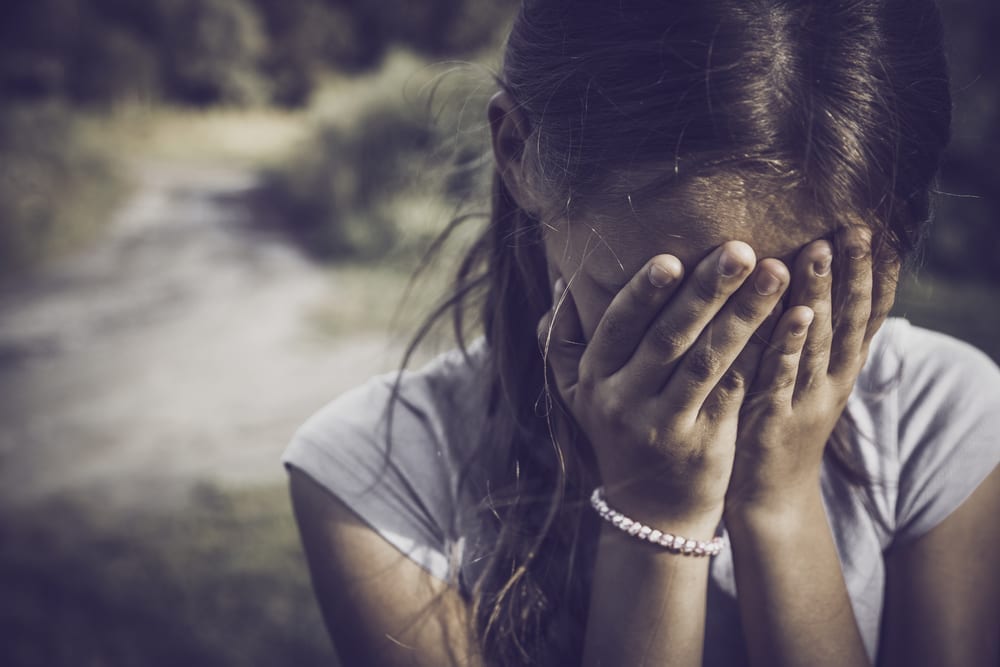Panic attacks in children can be terrifying. If you have to watch your child experiencing one, your first thought will probably be that there is something seriously and urgently wrong with their health.
It’s not uncommon for parents to run down to A&E with their child, only to find that the attack has gone by the time they get there.
Although panic attacks can be frightening they don’t usually do your child any physical harm and can pass within minutes.
However, they leave both you and your child reeling, feeling very upset and worried about what just happened and if it might happen again.
Anxiety in children is on the rise
In today’s fast-paced world with busy lives, more school testing and the pressures of social media our children are more anxious than ever before.
Recent figures show that the number of children having treatment for anxiety has risen over 60% in the last two years.
Childline’s research revealed that anxiety is growing problem for children and teenagers today. This has led to an increase in counselling sessions to help children cope, including thousands of children seeking help for panic attacks.
What it feels like to have a panic attack
Panic attacks in children often happen out of the blue and take both of you by surprise.
They literally stop your child in their tracks as they struggle to breathe, feel shaky and faint and their heart beats so fast, it feels like it might jump right out of their chest.
They can be a really terrifying experience for children, or indeed anyone, to go through.
Self.com asked people to describe what it feels like to have a panic attack. Sufferers said:
I couldn’t move, I couldn’t breathe, I started crying, I was shaking all over
(I thought) “Something’s wrong, something’s wrong, something’s wrong.” And then, “Oh God, I can’t stop, why isn’t it stopping? Why can’t I breathe, what’s going on?”
(I felt) a tightness in my chest so pronounced it actually feels like choking, dizziness like I’ve been hanging upside down for hours, tingling legs and numb hands. The exhaustion the next day is also uncanny. Your brain really makes your body pay for it.
Panic attacks pass in a few minutes but, as the above sufferers have described, the experience can leave your child feeling exhausted and wiped out afterwards.
What exactly is a panic attack?
A panic attack is a rush of intense anxiety. It’s the body’s way of telling you that you’re in danger and need to run away. The ‘fight or flight’ reflex kicks in and floods the body with adrenaline.
During a panic attack your child might experience the following symptoms:
- what feels like an irregular or racing heartbeat (palpitations)
- sweating
- trembling
- shortness of breath (hyperventilation)
- a choking sensation
- nausea
- dizziness
- tingling fingers
- ringing in their ears
(Source NHS)
Panic attacks last for around 5 minutes but can go on for as long as 15 minutes.
Although they pass relatively quickly this length of time can seem much much longer to the person having the attack and for the terrified parent witnessing it happen for the first time.
If your child has already had a panic attack then it’s much easier to recognise the symptoms and notice when they are having another. But the first one can be really scary for both you, as a parent, and for your child.
Are panic attacks the same as anxiety attacks?
Panic attacks are often confused with anxiety attacks. When your child has been worrying and stressing about a situation they might have an anxiety attack when it all gets too much.
For example your child might start feeling anxious about going to school and might get so worked up that they break down in the playground, sobbing and feeling shaky and breathless.
Unlike panic attacks, anxiety tends to simmer away, building up when the worries and stress becomes too much. Not everyone with anxiety ends up getting panic attacks.
A panic attack on the other hand can happen to anyone when they are generally overwhelmed with stress and worry. They are the result of underlying anxiety and can emerge of the blue and don’t always have a build up or an obvious trigger.
This can make them even scarier for children, as they don’t understand why it happened.
Sometimes it can end up being a Catch-22 situation because once your child has had a panic attack, they can begin to worry about it happening again.
This can lead to more anxiety as they start to avoid situations similar to when the first panic attack happened, which in turn can make it more likely that they will have another panic attack.
If my child has a panic attack have they got a mental health condition?
If your child has one panic attack it does not mean they have a mental health condition, such as panic disorder.
Sometimes children can have one panic attack and then no more. It’s only if they become more frequent and the fear of one happening starts to affect your child that you need to seek help.
The NHS advises that:
(Your child) may be diagnosed with panic disorder if you experience recurrent and unexpected panic attacks followed by at least a month of continuous worry or concern about having further attacks.
What to do if your child has a panic attack
Emma Saddleton, parents’ helpline operations manager at Young Minds has some practical tips for parents when their child has a panic attack.
The key thing is to stay as calm as you can. For you to be the calm in the storm at the time when your child is feeling so out of control.

Talk in calm tones
Saddleton suggests that mums or dads:
Talk in a soothing manner. Say: ‘Darling, everything is going to be okay’.
Talk to them, but don’t expect them to talk back. Tell them to listen to your voice, hold their hand, and keep explaining that it will pass.

Breathe together
She also recommends asking your child to breathe with you as you take in and exhale some long, slow breaths.
Sit with them and breathe in for 5 and out for 5. Then you can encourage your child to do the same.
They might not get to 5 at first but you can keep doing this for a few minutes.
Slowing down their breath will help ease the other symptoms that they are feeling in their panic attack.

Talk to them about what’s happened and why it’s happened.
After the initial panic is over and your child has had time to calm down, it’ worth speaking to them about what happened.
Explain to them that their body was reacting to stress and sending them signals to flee from danger. But that this danger wasn’t real.
Panic attacks are like false alarms. When your child’s body realises there is no actual danger, the physical feelings pass.
By understanding what has happened and why it happened, it can lessen a child’s anxiety of it happening again. If it does happen again they will at least know what is going on and what to expect.

Teach them coping mechanisms
Panic attacks are so frightening to go through and the prospect of having to go through it all again in the near future can be very scary for your child.
It can be useful to teach your child some coping mechanisms to try if they do. Even the simple act of talking about panic attacks openly and honestly with your child makes them less scary.
For example they could make breathing exercises part of their daily routine. A few minutes of breathing practices done daily can help them to remain calmer in general. This in turn prevents panic attacks from recurring.
If they do happen again, the practised breathing exercises can also help your child to calm down more quickly.
If your child begins to try to avoid situations similar to those when they had their last panic attack, then having coping mechanisms in place means that you can remind them that this time they have ways of coping with the attacks, if they do happen again.
When to seek help
If your child has frequent panic attacks and they begin to worry about when the next one may happen, then this can impact their life. It can make them more anxious and it can even interrupt their sleep.
They might end up avoiding situations that they worry could trigger another attack.
If any of the above is the case for your child, or if you are just concerned, then it’s worth getting help.
Talking therapies and CBT (cognitive behavioural therapy) are proven to help children understand panic attacks and learn how to cope if one strikes.
References
- Number of children having anxiety counselling rises 60 per cent, The Telegraph
- How To Help Your Child If They Are Having A Panic Attack, Huffington Post
- Are you having panic attacks?, NHS
- Panic disorder, NHS
- What’s the Difference Between a Panic Attack and an Anxiety Attack?, Healthline
- 9 People Describe What It Feels Like to Have a Panic Attack, Self.com


